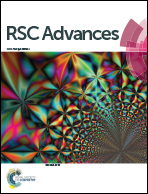A one-step hydrothermal preparation strategy for layered BiIO4/Bi2WO6 heterojunctions with enhanced visible light photocatalytic activities†
Abstract
Through the introduction of a new Bi-based semiconductor BiIO4, the novel BiIO4/Bi2WO6 heterojunctions composed of two layered structures were successfully fabricated by a one-step hydrothermal method. The as-prepared samples were thoroughly characterized by XRD, SEM, TEM, HRTEM, XPS, ICP, DRS and PL spectra technologies. The photodegradation experiments indicated that the BiIO4/Bi2WO6 composites showed much higher visible-light-driven (VLD) photocatalytic activity than those of either individual BiIO4 and Bi2WO6 for rhodamine B (RhB) degradation, which are attributed to the high separation of photogenerated electron–hole pairs resulted by the BiIO4/Bi2WO6 heterojunctions. This is the first report of the photocatalytic activity of the new Bi-based compound BiIO4 and BiIO4/Bi2WO6 composites under visible light. Moreover, our research provided a new layered semiconductor, which can be applied in the future for heterojunction construction and energy band structure design.


 Please wait while we load your content...
Please wait while we load your content...